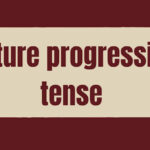The future perfect continuous tense, also known as the future perfect progressive tense, is used to describe an ongoing action that will be completed in the future before a specific time or event.
It indicates that the action will have been happening continuously for a duration of time up until that point in the future.
The future perfect continuous tense is formed using the auxiliary verb “will have been” followed by the present participle (base form + -ing) of the main verb.
Here is the basic structure:
Subject + will have been + present participle
Here are a few examples of the future perfect continuous tense:
1. By next month, I will have been studying English for three years.
(This suggests that the person has been studying English continuously up until next month, completing a total of three years of study.)
2. They will have been working on the project for six hours by the time the deadline arrives.
(This implies that the action of working on the project has been ongoing and will continue up until the deadline, totaling six hours.)
3. By the end of the week, she will have been living in this city for ten years.
(This indicates that her continuous residence in the city will reach a duration of ten years by the end of the week.)
In summary, the future perfect continuous tense emphasizes the ongoing nature of an action in the future that will continue up until a specific point, and it combines elements of both duration (continuous action) and completion (action that will be finished).
STRUCTURE OR FORMULA
The formula or structure of the future perfect continuous tense is as follows:
[Subject] + [will have been] + [present participle of the main verb]
Here’s a breakdown of each component:
1. Subject:
This is the noun or pronoun that performs the action or is associated with the action in the sentence.
2. will have been:
This is the auxiliary verb “will” followed by “have been.” It indicates that the action is taking place in the future and will be ongoing until a specific point.
3. Present participle:
This is formed by adding “-ing” to the base form of the main verb. It denotes the ongoing nature of the action.
Let’s see a few examples using the structure:
1. I will have been studying English for five years by the end of this semester.
2. They will have been traveling around the world for six months by the time they return.
3. She will have been working on the project all day long by the time the deadline arrives.
In these examples, the structure of the future perfect continuous tense is applied to convey ongoing actions that will continue up until a specific future point.
Here’s a breakdown of the structure of the future perfect continuous tense in positive, negative, and interrogative forms:
Positive:
[Subject] + [will have been] + [present participle of the main verb]
Negative:
[Subject] + [will not have been] + [present participle of the main verb]
Interrogative:
[Will] + [subject] + [have been] + [present participle of the main verb]?
Let’s see examples of each form:
Positive:
1. I will have been studying English for five years by the end of this semester.
2. They will have been traveling around the world for six months by the time they return.
3. She will have been working on the project all day long by the time the deadline arrives.
Negative:
1. I will not have been studying English for five years by the end of this semester.
2. They will not have been traveling around the world for six months by the time they return.
3. She will not have been working on the project all day long by the time the deadline arrives.
Interrogative:
1. Will I have been studying English for five years by the end of this semester?
2. Will they have been traveling around the world for six months by the time they return?
3. Will she have been working on the project all day long by the time the deadline arrives?
In each form, the structure remains the same, but the presence of “not” or the inversion of the subject and auxiliary verb “will” changes the meaning to negative or interrogative, respectively.
RULES
Here are the rules for using the future perfect continuous tense:
1. Formation:
The future perfect continuous tense is formed by using the auxiliary verb “will have been” followed by the present participle (-ing form) of the main verb.
2. Time reference:
The future perfect continuous tense is used to describe an ongoing action that will start in the present or past and will continue until a specific time or event in the future.
3. Duration:
The future perfect continuous tense emphasizes the duration of an action. It indicates that the action will have been happening continuously for a certain length of time.
4. Completion:
The future perfect continuous tense also implies that the action will be completed or finished at the specified future time or event.
5. Signal words:
Some common signal words or phrases associated with the future perfect continuous tense include “by [specific time/date/event],” “for [duration of time],” “how long,” “all day/night/week/month/year,” etc.
6. Affirmative form:
The affirmative form of the future perfect continuous tense follows the structure: [Subject] + [will have been] + [present participle of the main verb].
7. Negative form:
To create the negative form, simply add “not” after the auxiliary verb “will.” The structure becomes: [Subject] + [will not have been] + [present participle of the main verb].
8. Interrogative form:
In the interrogative form, the subject and the auxiliary verb “will” are inverted. The structure becomes: [Will] + [subject] + [have been] + [present participle of the main verb]?
Remember, the future perfect continuous tense is used to indicate ongoing actions that will continue up until a specific point in the future, emphasizing both duration and completion.
HOW TO EXPLAIN FUTURE PERFECT CONTINUOUS TENSE TO STUDENTS
Explaining the future perfect continuous tense to students can be done using the following step-by-step approach:
1. Introduce the concept:
Start by explaining that the future perfect continuous tense is used to talk about ongoing actions that will be happening in the future and will continue up until a specific time or event. Emphasize that it indicates the duration and completion of the action.
2. Formulation:
Break down the structure of the future perfect continuous tense, which consists of the auxiliary verb “will have been” followed by the present participle (-ing form) of the main verb.
3. Example sentences:
Provide clear examples to illustrate how the tense is used in context. Choose sentences that are relatable and relevant to the students’ lives or interests.
4. Signal words:
Explain that certain signal words or phrases are often associated with the future perfect continuous tense, such as “by [specific time/date/event],” “for [duration of time],” “how long,” “all day/night/week/month/year,” etc.
Discuss how these signal words help identify when the action will be completed in the future.
5. Contrast with other tenses:
Compare and contrast the future perfect continuous tense with other tenses, such as the future simple tense (e.g., “I will study”) and the present perfect continuous tense (e.g., “I have been studying”).
Highlight the differences in terms of time reference and duration.
6. Practice exercises:
Engage the students in exercises or activities that involve forming sentences using the future perfect continuous tense.
This can include fill-in-the-blank exercises, creating their own sentences, or even role-playing scenarios.
7. Reinforcement and application:
Provide opportunities for students to use the future perfect continuous tense in speaking and writing activities.
Encourage them to incorporate the tense into their own conversations and written work, ensuring they understand when and how to use it accurately.
8. Review and feedback:
Regularly review the concept and provide feedback on students’ usage of the future perfect continuous tense.
Offer corrections and explanations to help them improve their understanding and application of the tense.
By following these steps, students can gradually grasp the concept and confidently use the future perfect continuous tense in their own communication.
Exercise:
1. By the end of the year, I ________________ (work) at this company for 10 years.
2. Will they ________________ (wait) for us for two hours when we arrive?
3. She ___________________ (study) French for six months by the time she goes to Paris.
4. We ___________________ (live) in this city for five years by next summer.
5. By tomorrow, he ___________________ (play) the piano for three hours straight.
6. Will you ___________________ (wait) for me until I finish my meeting?
7. They ___________________ (travel) around the world for a year by the time they return home.
8. By next week, the team ___________________ (work) on this project for three months.
9. Will she ___________________ (practice) the guitar for five hours by this evening?
10. I ___________________ (study) for the exam all day long by the time it starts.
Answers:
1. By the end of the year, I will have been working at this company for 10 years.
2. Will they have been waiting for us for two hours when we arrive?
3. She will have been studying French for six months by the time she goes to Paris.
4. We will have been living in this city for five years by next summer.
5. By tomorrow, he will have been playing the piano for three hours straight.
6. Will you have been waiting for me until I finish my meeting?
7. They will have been traveling around the world for a year by the time they return home.
8. By next week, the team will have been working
on this project for three months.
9. Will she have been practicing the guitar for five hours by this evening?
10. I will have been studying for the exam all day long by the time it starts.
Learn more Tenses
- Simple present tense
- Simple past tense
- Simple future tense
- Present progressive tense
- Past progressive tense
- Future progressive tense
- Present perfect tense
- Past perfect tense
- Future perfect tense
- Present perfect continuous tense
- Past perfect continuous tense
- Tenses in English grammar




